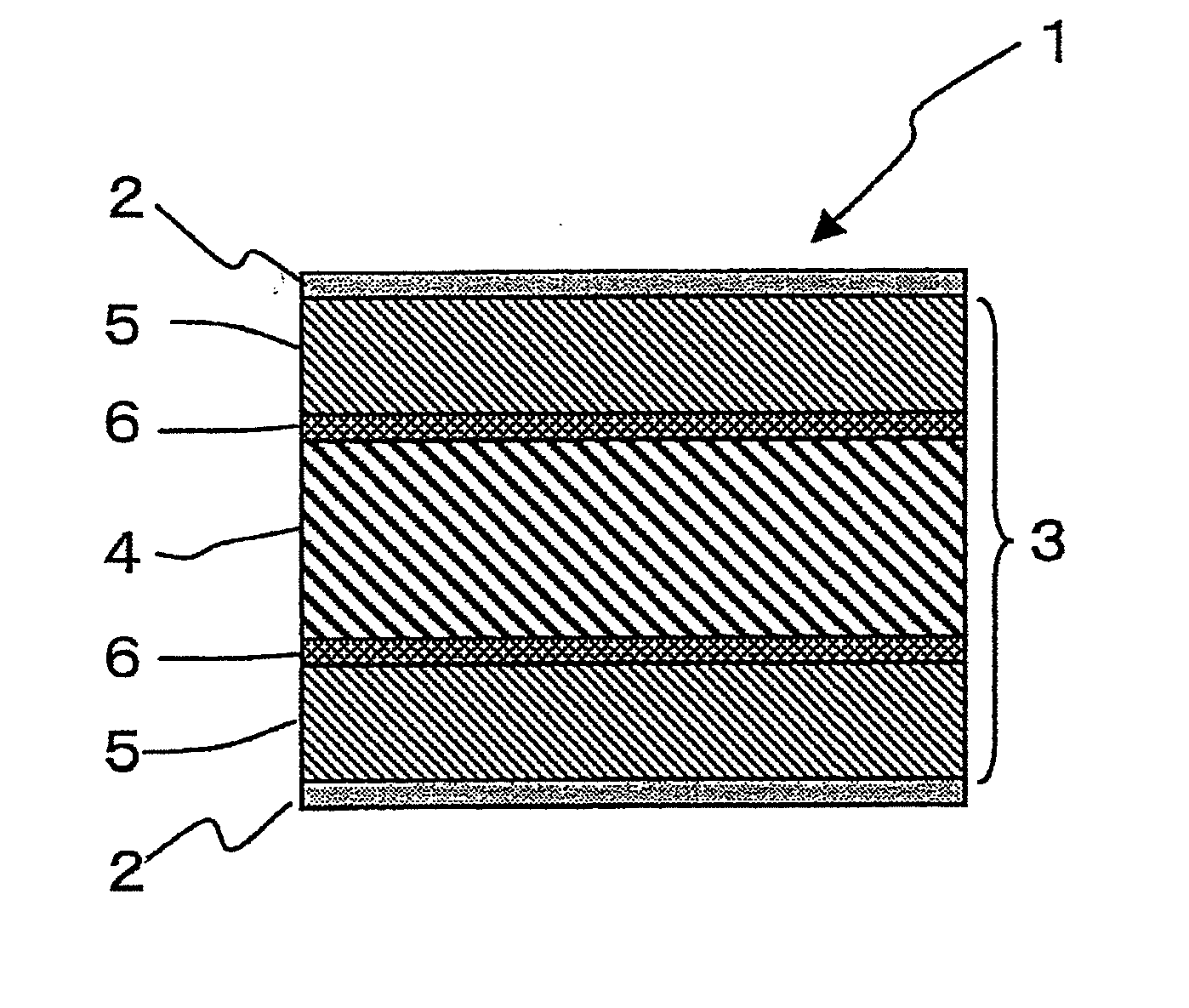Electrophotographic recording sheet and recorded material
a technology of electrophotographic recording and recorded material, which is applied in the direction of cellulosic plastic layered products, instruments, non-fibrous pulp addition, etc., can solve the problems of large apparatus, poor color tone of image formed, and inability to discharge the charge given to the recoding sheet inside the printer, etc., to achieve excellent recording quality, good fixability, and good practicability
- Summary
- Abstract
- Description
- Claims
- Application Information
AI Technical Summary
Benefits of technology
Problems solved by technology
Method used
Image
Examples
preparation example 1
[0139]100 parts by weight of polyethylene glycol monomethacrylate (by Nippon Yushi, trade name: Blemmer PE-350), 20 parts by weight of lithium perchlorate (by Wako Pure Chemical Industries, chemical reagent), 1 part by weight of hydroquinone (by Wako Pure Chemical Industries, chemical reagent), and 400 parts by weight of methyl ethyl ketone were put into a four-neck flask equipped with a stirrer, a condenser, a nitrogen-introducing duct, and a thermometer, and the system was purged with nitrogen, and reacted at 60° C. for 40 hours. 20 parts by weight of stearyl methacrylate (by Wako Pure Chemical Industries, chemical reagent), 20 parts by weight of n-butyl methacrylate (by Wako Pure Chemical Industries, chemical reagent), and 1 part by weight of azobisisobutyronitrile (by Wako Pure Chemical Industries, chemical reagent) were added to it, and polymerized at 80° C. for 3 hours, then methyl ethyl ketone was added thereto to control the solid content to be 20...
preparation example 2
[0140]60 parts by weight of polyethylene glycol having a weight-average molecular weight of 1000 (by Wako Pure Chemical Industries, chemical reagent), 40 parts by weight of polypropylene glycol having a weight-average molecular weight of 600 (by Wako Pure Chemical Industries, chemical reagent), 15 parts by weight of lithium perchlorate (by Wako Pure Chemical Industries, chemical reagent), and 400 parts by weight of methyl ethyl ketone were put into a four-neck flask equipped with a stirrer, a condenser, a nitrogen-introducing duct, and a thermometer, and the system was purged with nitrogen, and reacted at 80° C. for 10 hours. 30 parts by weight of isophorone diisocyanate (by Wako Pure Chemical Industries, chemical reagent), and 0.5 parts by weight of 1,8-diazabicyclo[5.4.0]undecene-7 (by San-apro, trade name: DBU) were added to it to attain urethanation at 80° C. for 4 hours; and 20 parts by weight of methacrylic acid (by Wako Pure Chemical Industries, ch...
production example 1
for Support
[0141]A synthetic resin film, polyethylene terephthalate film having a thickness of 25 μm (by Toray, trade name: Lumirror, melting point: 260° C.) was prepared; and an adhesive coating composition comprising 60 parts by weight of a polyether-urethane adhesive (by Toyo Morton, trade name: TM-317), 40 parts by weight of a polyisocyanate curing agent (by Toyo Morton, trade name: CAT-11B), and 5 parts by weight of a benzotriazole UV absorbent (by Ciba Speciality Chemicals, trade name: Tinuvin-384-2) was applied to it so that the dry solid content of the coating layer could be 4 g / m2, and dried at 60° C. for 1 minute, thereby providing an adhesive layer serving also as a UV-intercepting layer. This was put on the surface and the back of a water-resistant paper material, printing paper OTP base having a thickness of 170 μm (by Oji Paper Milling, Cobb's method water absorbency: 24.8 g / m2, weight: 175 g / m2), and adhered thereto under pressure, thereby giving a water-resistant sup...
PUM
| Property | Measurement | Unit |
|---|---|---|
| temperature | aaaaa | aaaaa |
| melting point | aaaaa | aaaaa |
| thickness | aaaaa | aaaaa |
Abstract
Description
Claims
Application Information
 Login to View More
Login to View More - R&D
- Intellectual Property
- Life Sciences
- Materials
- Tech Scout
- Unparalleled Data Quality
- Higher Quality Content
- 60% Fewer Hallucinations
Browse by: Latest US Patents, China's latest patents, Technical Efficacy Thesaurus, Application Domain, Technology Topic, Popular Technical Reports.
© 2025 PatSnap. All rights reserved.Legal|Privacy policy|Modern Slavery Act Transparency Statement|Sitemap|About US| Contact US: help@patsnap.com



